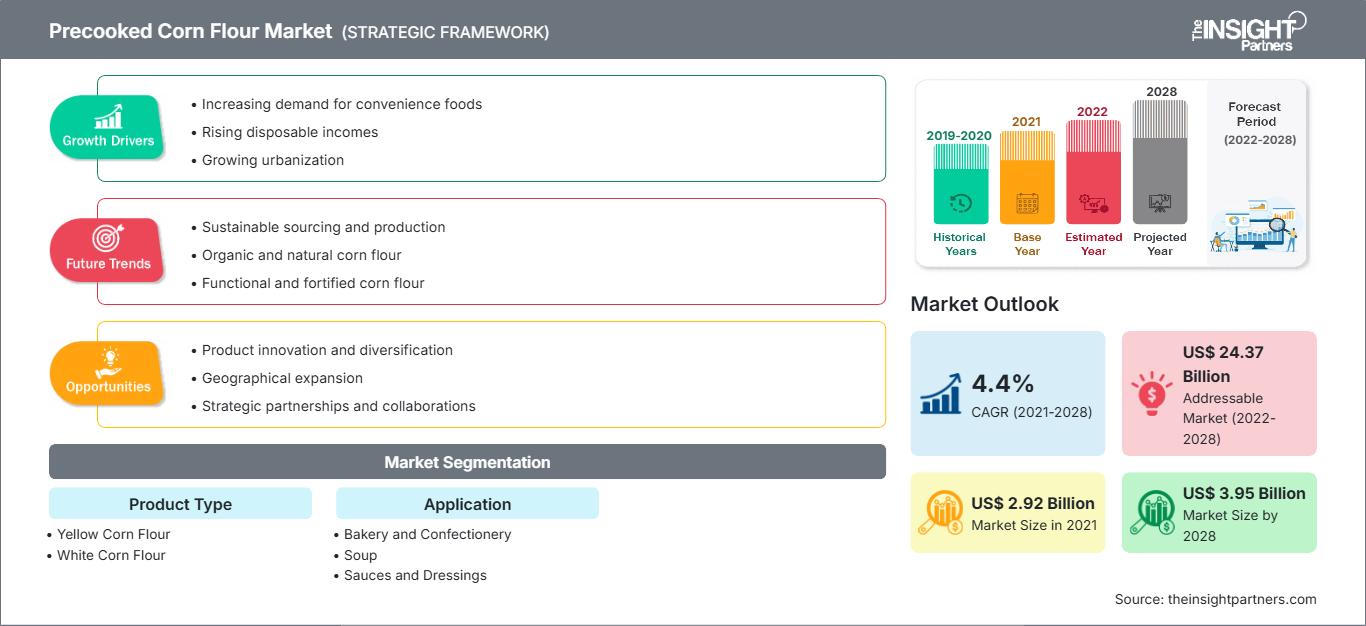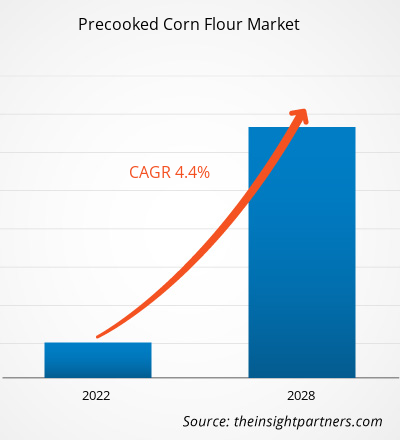Le marché de la farine de maïs précuite était évalué à 2 918,78 millions de dollars américains en 2021 et devrait atteindre 3 953,67 millions de dollars américains d'ici 2028 ; il devrait croître à un TCAC de 4,4 % entre 2021 et 2028.
La farine de maïs précuite est sans gluten et constitue un ingrédient essentiel pour la préparation de tortillas, de tamales et d'autres plats mexicains. L'adoption de la cuisine mexicaine à travers le monde augmente la consommation de farine de maïs précuite.
En 2020, l'Asie-Pacifique a dominé le marché mondial de la farine de maïs précuite et devrait maintenir cette domination au cours de la période de prévision. La sensibilisation croissante aux bienfaits pour la santé et à la richesse nutritionnelle offerte par les produits préparés à partir de farine de maïs précuite stimule la croissance du marché de la farine de maïs précuite dans la région. De plus, l'augmentation du revenu disponible des personnes et l'augmentation des applications de farine de maïs précuite ont entraîné une demande croissante de farine de maïs précuite. De plus, l’adoption et la consommation croissantes de nourriture mexicaine dans des pays comme l’Australie et l’Inde stimulent la demande de farine de maïs précuite.
Vous bénéficierez d’une personnalisation sur n’importe quel rapport - gratuitement - y compris des parties de ce rapport, ou une analyse au niveau du pays, un pack de données Excel, ainsi que de profiter d’offres exceptionnelles et de réductions pour les start-ups et les universités
Marché de la farine de maïs précuite: Perspectives stratégiques

- Obtenez les principales tendances clés du marché de ce rapport.Cet échantillon GRATUIT comprendra une analyse de données, allant des tendances du marché aux estimations et prévisions.
Aperçu du marché
Demande croissante de produits alimentaires sans gluten
Une consommation excessive de gluten peut entraîner de graves problèmes de santé tels que la sensibilité, l'allergie au blé et la maladie cœliaque. Selon l'Organisation mondiale de gastroentérologie (WGO), la maladie cœliaque touche des personnes de tous âges. De plus, selon l'Institut de médecine fonctionnelle, l'incidence de la maladie cœliaque augmente de 7,5 % par an, les incidences étant les plus élevées chez les femmes et les enfants. La demande accrue de produits alimentaires sans gluten est due à une augmentation des consommateurs soucieux de leur santé. Ces facteurs stimulent la demande de produits alimentaires sans gluten.
Aperçu des types de produits
Selon le type de produit, le marché de la farine de maïs précuite est classé en farine de maïs jaune, farine de maïs blanc et autres. En 2020, le segment de la farine de maïs jaune dominait le marché. L'utilisation croissante de la farine de maïs jaune en boulangerie stimule la demande de farine de maïs précuite. Elle est utilisée pour la fabrication de biscuits grâce à sa texture onctueuse et à ses excellentes propriétés liantes. De plus, les minéraux et vitamines contenus dans la farine de maïs jaune favorisent son utilisation dans une large gamme de produits alimentaires nutritifs.
Les principaux acteurs du marché adoptent des stratégies telles que les fusions-acquisitions et les lancements de produits pour étendre leur présence géographique et leur clientèle. Quelques-uns des principaux acteurs opérant sur le marché de la farine de maïs précuite sont Archer Daniels Midland Company, Cargill Incorporated, Limagrain (Limagrain Ingredients), Agricor, Buhler, Favero Antonio SRL, Molino Peila SpA, SEMO Milling LLC, Bunge Limited et Gruma SAB de CV.
Points forts du rapport
- Tendances progressives du marché de la farine de maïs précuite pour aider les acteurs à développer des stratégies efficaces à long terme
- Stratégies de croissance adoptées par les entreprises pour assurer la croissance sur les marchés développés et en développement
- Analyse quantitative du marché mondial de la farine de maïs précuite de 2019 à 2028
- Estimation de la demande de farine de maïs précuite dans divers secteurs
- Analyse de Porter pour illustrer l'efficacité des acheteurs et des fournisseurs opérant dans le secteur pour prédire la croissance du marché
- Évolutions récentes pour comprendre le scénario de marché concurrentiel et la demande de maïs précuit farine
- Tendances et perspectives du marché, associées aux facteurs qui stimulent et freinent la croissance du marché de la farine de maïs précuite
- Comprendre les stratégies qui sous-tendent l'intérêt commercial concernant la croissance du marché mondial de la farine de maïs précuite, facilitant le processus de prise de décision
- Taille du marché de la farine de maïs précuite à différents nœuds du marché
- Aperçu détaillé et segmentation du marché mondial de la farine de maïs précuite ainsi que sa dynamique industrielle
- Taille du marché de la farine de maïs précuite dans diverses régions avec des opportunités de croissance prometteuses
L'« Analyse du marché mondial de la farine de maïs précuite jusqu'en 2028 » est une étude spécialisée et approfondie de l'industrie des biens de consommation avec un accent particulier sur l'analyse des tendances du marché mondial de la farine de maïs précuite. Le rapport vise à fournir un aperçu du marché avec une segmentation détaillée du marché. Le marché de la farine de maïs précuite est segmenté en fonction du type de produit, de l'application et de la géographie. Selon le type de produit, le marché est divisé en farine de maïs jaune, farine de maïs blanc et autres. Selon l'application, le marché de la farine de maïs précuite est segmenté en boulangerie et confiserie, soupes, sauces et vinaigrettes, plats et aliments prêts à consommer, snacks extrudés, etc. Géographiquement, le marché de la farine de maïs précuite est segmenté en cinq grandes régions : Amérique du Nord, Europe, Asie-Pacifique, Moyen-Orient et Afrique, et Amérique du Sud et centrale.
Marché de la farine de maïs précuite
Les tendances régionales et les facteurs influençant le marché de la farine de maïs précuite tout au long de la période de prévision ont été analysés en détail par les analystes de The Insight Partners. Cette section aborde également les segments et la répartition géographique du marché de la farine de maïs précuite en Amérique du Nord, en Europe, en Asie-Pacifique, au Moyen-Orient et en Afrique, ainsi qu'en Amérique du Sud et en Amérique centrale.
Portée du rapport sur le marché de la farine de maïs précuite| Attribut de rapport | Détails |
|---|---|
| Taille du marché en 2021 | US$ 2.92 Billion |
| Taille du marché par 2028 | US$ 3.95 Billion |
| TCAC mondial (2021 - 2028) | 4.4% |
| Données historiques | 2019-2020 |
| Période de prévision | 2022-2028 |
| Segments couverts |
By Type de produit
|
| Régions et pays couverts | Amérique du Nord
|
| Leaders du marché et profils d'entreprises clés |
|
Densité des acteurs du marché de la farine de maïs précuite : comprendre son impact sur la dynamique commerciale
Le marché de la farine de maïs précuite connaît une croissance rapide, portée par une demande croissante des utilisateurs finaux, due à des facteurs tels que l'évolution des préférences des consommateurs, les avancées technologiques et une meilleure connaissance des avantages du produit. Face à cette demande croissante, les entreprises élargissent leur offre, innovent pour répondre aux besoins des consommateurs et capitalisent sur les nouvelles tendances, ce qui alimente la croissance du marché.
- Obtenez le Marché de la farine de maïs précuite Aperçu des principaux acteurs clés
Profils d'entreprise
- Archer Daniels Midland Company
- Cargill Incorporated
- Limagrain (ingrédients Limagrain)
- Agricor
- Buhler
- Favero Antoniop SRL
- Molino Peila SpA
- SEMO Milling LLC
- Bunge Limited
- Gruma SAB de CV
- Analyse historique (2 ans), année de base, prévision (7 ans) avec TCAC
- Analyse PEST et SWOT
- Taille du marché Valeur / Volume - Mondial, Régional, Pays
- Industrie et paysage concurrentiel
- Ensemble de données Excel
Rapports récents
Rapports connexes
Témoignages
Raison d'acheter
- Prise de décision éclairée
- Compréhension de la dynamique du marché
- Analyse concurrentielle
- Connaissances clients
- Prévisions de marché
- Atténuation des risques
- Planification stratégique
- Justification des investissements
- Identification des marchés émergents
- Amélioration des stratégies marketing
- Amélioration de l'efficacité opérationnelle
- Alignement sur les tendances réglementaires




















 Obtenez un échantillon gratuit pour - Marché de la farine de maïs précuite
Obtenez un échantillon gratuit pour - Marché de la farine de maïs précuite